 Typically, structures such as the IKAROS shown here are considered potential space sails . But another use of them, if you place them at the right point, can be blocking part of the sunlight, which will help cool the Earth.Global climate change
Typically, structures such as the IKAROS shown here are considered potential space sails . But another use of them, if you place them at the right point, can be blocking part of the sunlight, which will help cool the Earth.Global climate change is one of the most pressing problems facing humanity today. Science is very clear about what is happening: the Earth is warming up, the cause of which are the greenhouse gases emitted by human activity, and the concentration of these gases only continues to grow with time, without ceasing. And although there are a lot of calls to reduce emissions, to collect carbon, to abandon fossil fuels, little has been done effectively. The earth continues to warm up, sea levels rise, and the global climate changes. Can we take a different approach and partially block the light coming from the sun? This question is asked by our reader:
Why don't we consider building a solar screen in space that changes the amount of light (energy) coming to Earth? All who have experienced a total eclipse, know that the temperature decreases, and the light is muffled. The idea is to do something between us and the Sun for a whole year.
This is one of the most ambitious, but also the most sensible options that we can consider in the fight against global climate change.

In general, it is well known that increasing the concentration of greenhouse gases in the atmosphere is the cause of global warming, which, in turn, changes the climate and weather patterns in many aspects. The consequences of most of them are usually considered bad for most people in the world, and therefore there is a global movement to combat them. If you do not choose the most popular solution, the return of Earth’s atmospheric gases to pre-industrial levels, then the only remaining options for humanity will be adaptation to changes or the use of
geo -
engineering solutions.
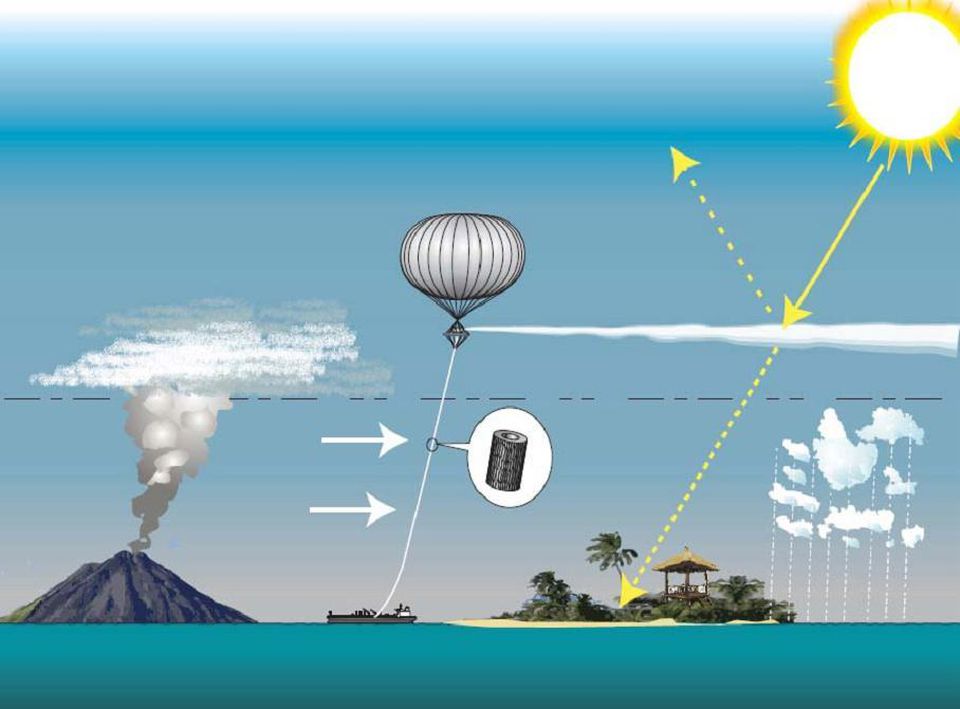 The SPICE project will explore the feasibility of one of the so-called geo-engineering techniques: stimulation of natural processes that release small particles into the stratosphere, which will reflect a few percent of the solar radiation that comes to us, which will cool the Earth. But there may be extremely undesirable side effects.
The SPICE project will explore the feasibility of one of the so-called geo-engineering techniques: stimulation of natural processes that release small particles into the stratosphere, which will reflect a few percent of the solar radiation that comes to us, which will cool the Earth. But there may be extremely undesirable side effects.The last option, geoengineering, is not without risks. Most decisions involve further changes to the surface or atmosphere of the Earth, with mostly unknown and unpredictable consequences. Of all the geo-engineering options, the least risky would be the one proposed by our reader: to launch something into space far from Earth to block some of the sunlight. With a decrease in solar radiation, it is possible to control the temperature, even if the concentration of the greenhouse gas in the atmosphere continues to grow. If we wanted to completely reverse the influence of all global warming that has occurred since the beginning of the industrial revolution, we would have had to permanently block about 2% of the sunlight.
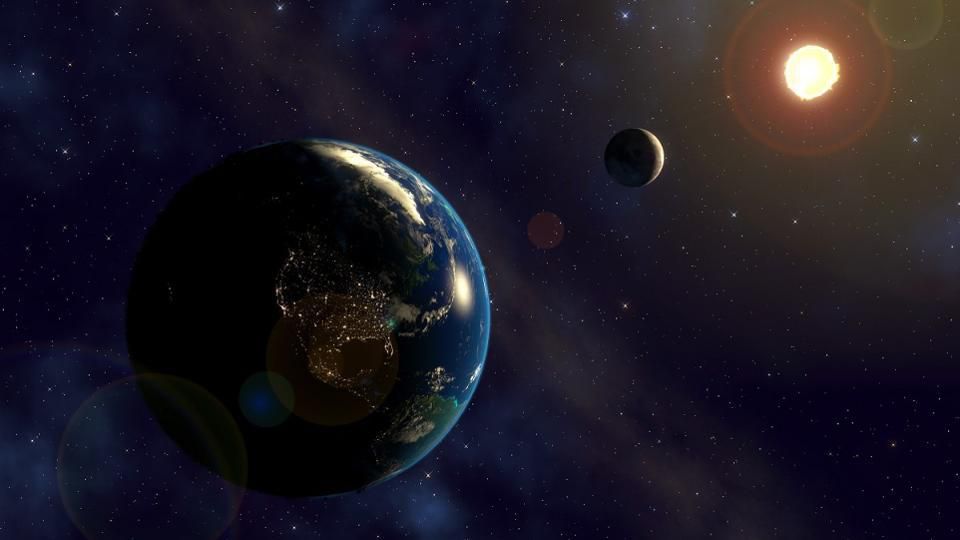 Solar eclipses are possible on Earth, they occur when the Moon is aligned on the Earth-Sun plane during a new moon. The object may be smaller or farther away, and not cast shadows on our planet, but at the same time reduce the amount of sunlight reaching the Earth.
Solar eclipses are possible on Earth, they occur when the Moon is aligned on the Earth-Sun plane during a new moon. The object may be smaller or farther away, and not cast shadows on our planet, but at the same time reduce the amount of sunlight reaching the Earth.But, at least theoretically, this is easier to accomplish than you might think. Between the Earth and the Sun there is a gravitationally quasi-stable point, which, in fact, will always be in the path of sunlight. It is known as
the Lagrange point L1, and is the ideal location for a satellite that must remain exactly between the Earth and the Sun. When the Earth moves in orbit around the Sun, an object located in L1 will always remain between the Earth and the Sun, and never deviate from this point throughout the year. Its physical location is in interplanetary space, about 1,500,000 km closer to the Sun than to the Earth.
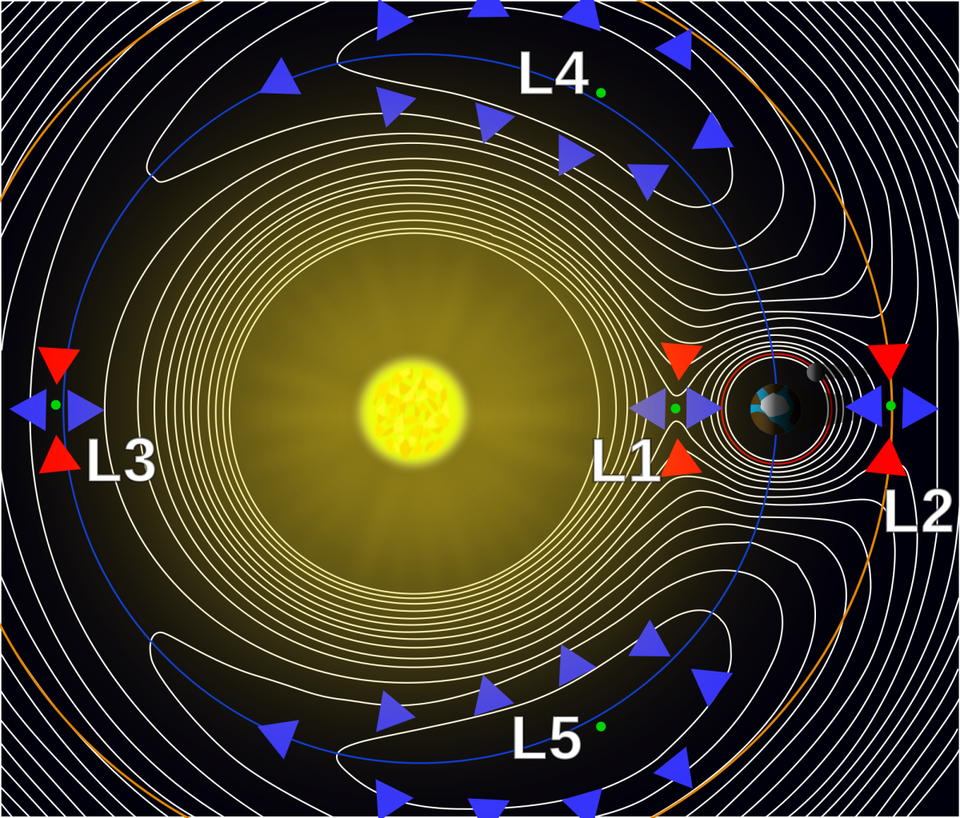 Contour graph of the effective potentials of the Earth-Sun system. Objects can be in stable moon-like orbits around the Earth, or in quasistable orbits, following ahead of or behind the Earth. Point L1 is ideal for permanent blocking of sunlight.
Contour graph of the effective potentials of the Earth-Sun system. Objects can be in stable moon-like orbits around the Earth, or in quasistable orbits, following ahead of or behind the Earth. Point L1 is ideal for permanent blocking of sunlight.At such a distance, even an object the size of Earth will not cast a shadow on our planet, since the cone of its shadow will end long before it reaches our world. But one shadow, or several small shadows, in fact, will block enough light to reduce the amount of radiation reaching the Earth. To achieve a level of reduction sufficient to counter global warming, that is, in order to reduce incoming radiation by 2%, it will be necessary to cover an area of 4.5 million square meters. km at point L1. This is equivalent to the size of an object that occupies half the surface area of the moon. But, unlike the moon, we can divide it into as many small objects as necessary.
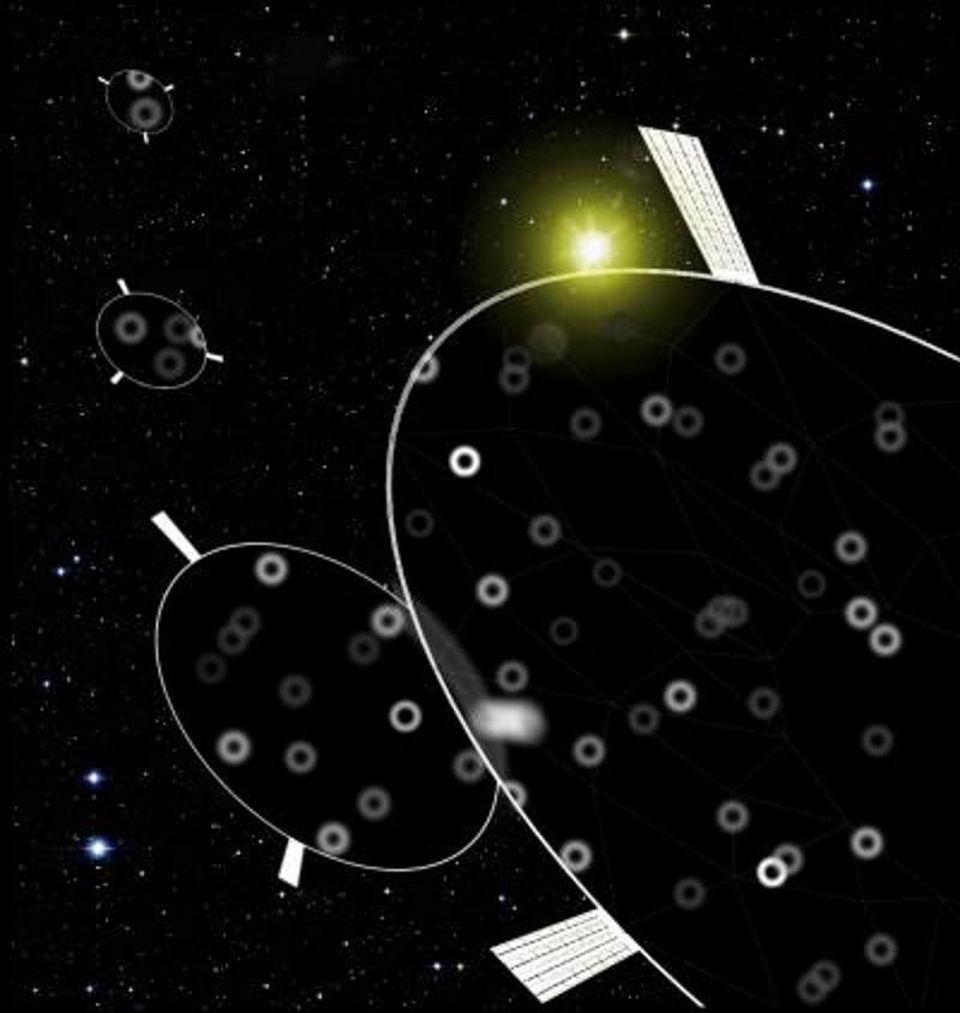 The figure shows objects with a diameter of 60 cm at the point L1. They are transparent, but they erode the transmitted light in the shape of a donut, as can be seen in the example of stars in the background. Sunlight is also eroded, and passes by the Earth. This method of eliminating light eliminates the influence of radiation pressure, which otherwise would have resulted in degradation of the L1 orbit.
The figure shows objects with a diameter of 60 cm at the point L1. They are transparent, but they erode the transmitted light in the shape of a donut, as can be seen in the example of stars in the background. Sunlight is also eroded, and passes by the Earth. This method of eliminating light eliminates the influence of radiation pressure, which otherwise would have resulted in degradation of the L1 orbit.One of the
proposals put forward by Roger Angel, an astronomer from the University of Arizona, suggests launching a group of small spacecraft to L1. Instead of a huge and heavy structure, it will be an array of 16 trillion objects, each of which is a circle of about 30 cm in radius. Such an array is able to block enough radiation. It will not create any shadow on Earth, but will evenly reduce the total amount of light reaching the surface of the planet, which will be equivalent to a huge number of dark spots scattered across the surface of the Sun.
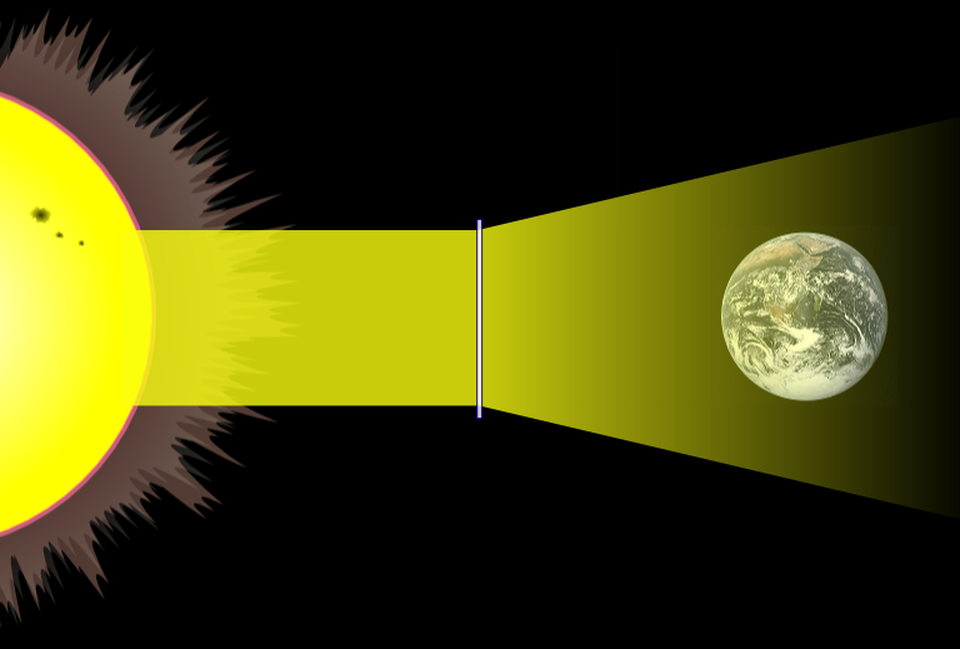 The principle of the cosmic lens. Its main function is to soften global warming by breaking the light so that it goes past the Earth. In fact, you need a smaller and thinner lens than shown here.
The principle of the cosmic lens. Its main function is to soften global warming by breaking the light so that it goes past the Earth. In fact, you need a smaller and thinner lens than shown here.Another
proposal put forward by James Earlly in 1989 is to place a very large lens in space. You can make a glass shield, working as a lens, and scattering a large amount of light away from the Earth. A huge cosmic lens, or a set of small lenses that need to be only a few millimeters thick, to refract light, and then quite a lot of light that could collide with Earth will be moved into interplanetary space. At point L1, the lens (or set of lenses) will have to cover about a million square meters. km. to reduce solar energy reaching Earth by 2%.
In principle, it sounds simple, and potentially, it is a solution to the problem of global warming with little risk and big benefits. But with him there are two problems.
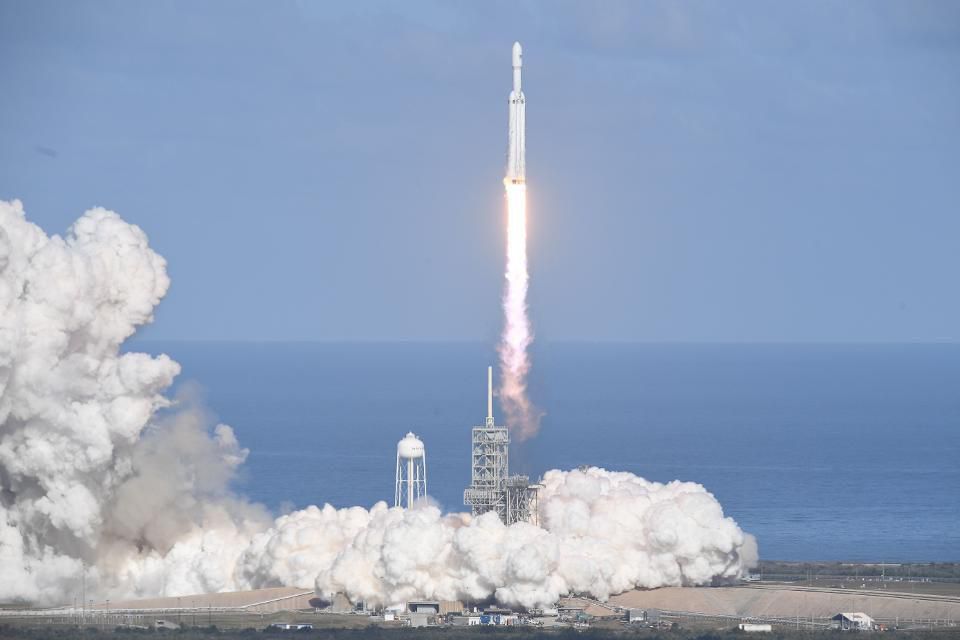 The very first launch of Falcon Heavy on February 6, 2018 was successful. The rocket reached a low orbit, successfully delivered the cargo, and the main engines returned to Cape Kennedy, where they landed successfully. The promise of a reusable rocket has become a reality, and it can reduce the cost of launching goods to $ 2,000 per kilogram.1) Startup cost.
The very first launch of Falcon Heavy on February 6, 2018 was successful. The rocket reached a low orbit, successfully delivered the cargo, and the main engines returned to Cape Kennedy, where they landed successfully. The promise of a reusable rocket has become a reality, and it can reduce the cost of launching goods to $ 2,000 per kilogram.1) Startup cost. The space program of mankind is able to send an object to the point L1. We have done this many times - it is there that almost all missions are sent with satellites watching the sun. But the cost of launching even very thin and light spacecraft will be unreal. If we take Angel’s proposal for transparent thin films, and each film will be only 1/200 mm thick and weigh one gram, their total weight will be 20 million tons. Even if the cost of starting next-generation technologies, such as the Falcon Heavy,
could drop to $ 2,000 per kg (ten times less than now), we still get hundreds of billions of dollars. And we have not yet reached the second problem.
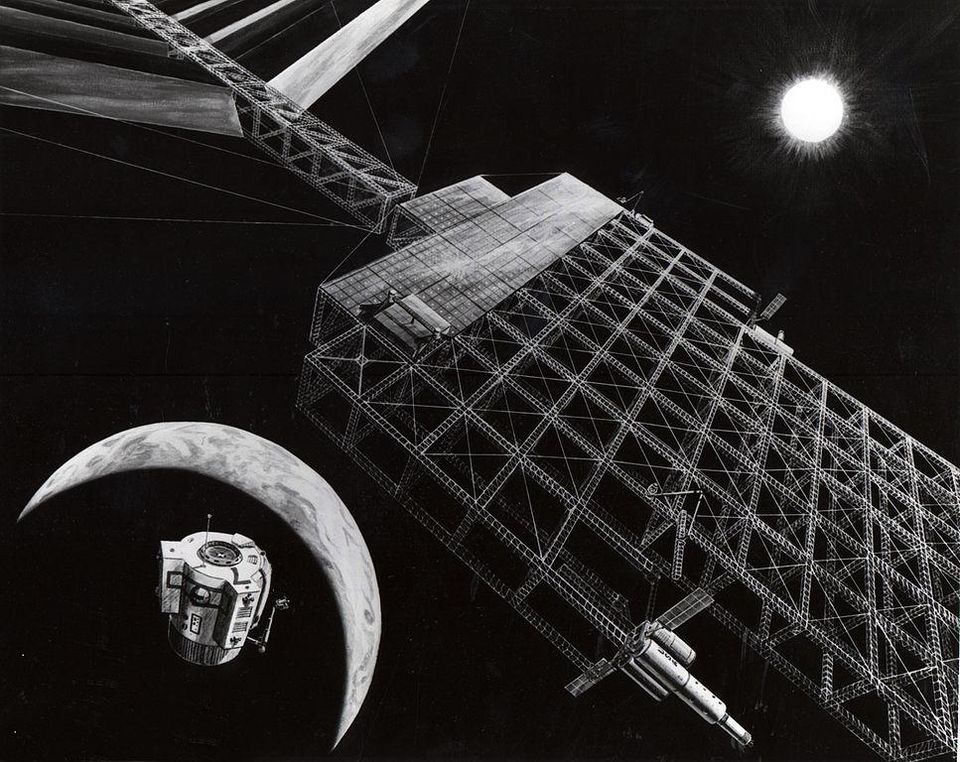 NASA conceived a solar energy satellite in the 1970s. If several satellites are placed at the L1 point to collect solar energy, they can not only block some of the sunlight, but also provide useful energy for other purposes. But the point L1 is unstable.2) Orbital stability.
NASA conceived a solar energy satellite in the 1970s. If several satellites are placed at the L1 point to collect solar energy, they can not only block some of the sunlight, but also provide useful energy for other purposes. But the point L1 is unstable.2) Orbital stability. Point L1 is only quasi-stable, that is, either everything that we launch there must be maintained with the help of engines in the desired orbit, or it will eventually float away from there and stop blocking sunlight. And this will happen too quickly by our standards: in the time span from several years to several decades, depending on the success of the initial launch into orbit. And this means that in order to block the light, we will need expenditures of tens of billions of dollars a year just to support the launches: which is comparable to the annual budget of NASA. And this is only if the cost of launches is reduced 10 times from today.
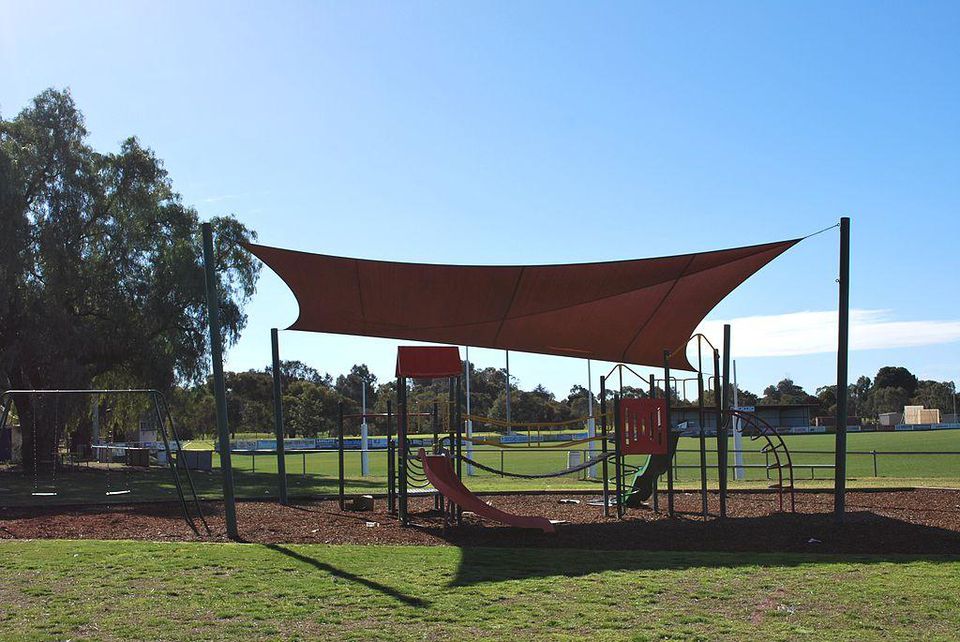 Just as a shadow on Earth can lower the temperature by reducing the amount of sunlight coming in, so several devices blocking light in space can reduce the amount of light reaching the Earth.
Just as a shadow on Earth can lower the temperature by reducing the amount of sunlight coming in, so several devices blocking light in space can reduce the amount of light reaching the Earth.The great advantage of remote blocking of light is that there is no risk of the occurrence of long-term negative effects on the Earth associated with geo-engineering solutions. Other ideas, such as large-scale atmospheric changes, many low-orbit satellites around the Earth, injection of cloud-forming substances or reflective particles into the sky or ocean, can potentially have disastrous unpredictable consequences. But the biggest obstacles today are cost and long-term stability issues.
 The concentration of carbon dioxide in the Earth’s atmosphere can be determined from measurements of ice cores, as well as from atmospheric tracking stations. The increase in the amount of CO 2 in the atmosphere from the middle of the XVIII century is striking, and continues to go, without weakening.
The concentration of carbon dioxide in the Earth’s atmosphere can be determined from measurements of ice cores, as well as from atmospheric tracking stations. The increase in the amount of CO 2 in the atmosphere from the middle of the XVIII century is striking, and continues to go, without weakening.In the meantime, the planet continues to warm up, the level of CO
2 continues to grow, and there are no effective strategies for changing the situation. The ideas of such screens, which are usually called the "
space awning ", can be our best option. And although its cost is impossible high, in the long run it may be the cheapest option that we want to realize. But years, decades, centuries and millennia pass, and our descendants will have to deal with the consequences of our actions or inaction over the next generations.